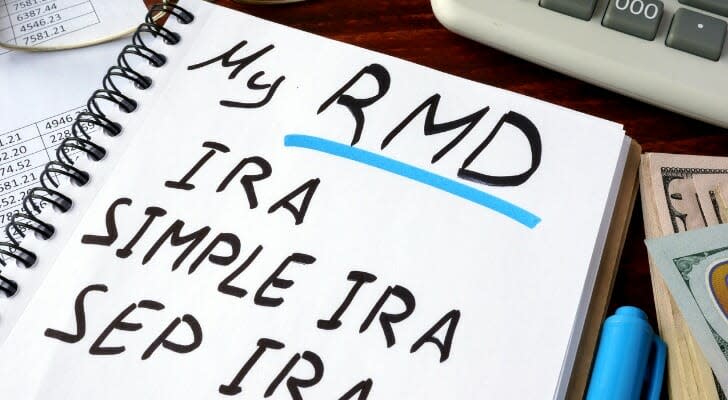Do I Owe Taxes on a Retirement Account Distribution?
A retirement plan distribution occurs when you withdraw money from the plan. There are several different types of distributions, including early distributions, rollover distributions and Required Minimum Distributions. You generally owe income taxes on most types of withdrawals and you may owe an additional penalty if the withdrawal is made before age 59.5. For help drawing up a plan for withdrawing from your retirement accounts, consider talking to a financial advisor.
Retirement Distribution Defined
A distribution from a retirement plan is equivalent to a withdrawal of funds. Any time you take money out of your retirement plan, it is a distribution. Taking money out may also be referred to as a withdrawal. The two terms can be considered synonymous.
Distributions can be taken from any type of retirement savings plan. These include defined benefit plans such as corporate pensions as well as defined contribution plans, including 401(k) plans and Individual Retirement Accounts.
A number of rules govern retirement plan distributions and there can be financial penalties for breaking the rules. Many rules concern the timing of distributions. For instance, withdrawing funds from a tax-advantaged retirement plan such as a 401(k) before you have reached the age of eligibility generally incurs a penalty. Other rules may oblige you to pay penalties if you don’t take distributions when they are required.
If you’re ready to be matched with local advisors that can help you achieve your financial goals, get started now.
Different Types of Distributions
There are several different types of retirement plan distributions. The type of distribution can be determined by the plan type as well as and timing of the distribution. The original source of the funds being withdrawn may also be a factor. Here are some types of distributions:
Normal distributions: A normal distribution occurs when you take funds from the plan after you have reached the retirement age specified by the plan. This age may differ from plan to plan, but is usually age 59.5.
Early distribution: An early distribution is one taken before the official retirement age. Early distributions are normally subject to a penalty, plus payment of any taxes owed.
Required Minimum Distribution (RMD): RMDs are withdrawals that must be taken from most tax-advantaged defined contribution plans after the participant has reached 72.
Qualified distribution: A qualified distribution is one taken from a plan considered by the Internal Revenue Service to be a qualified retirement plan, such as a corporate pension. It can also refer to a distribution from a Roth that is not subject to any fees or taxes.
Periodic distribution: A periodic distribution is one that occurs on a regular schedule. The monthly benefits received by people covered by pension plans are examples of periodic distributions.
Lump sum distribution: A lump sum distribution, also called a non-periodic distribution, is a one-time distribution that a plan participant may choose to receive instead of periodic distributions.
Rollover distributions: A special distribution called a rollover occurs when a plan participant withdraws funds from a retirement plan and then deposits them into a new retirement plan. If the funds are not deposited into the new plan within 60 days of withdrawal, the distribution may be treated as an early distribution subject to penalties and taxes.
Roth retirement accounts have their own special rules. Account owners can always take distributions of funds they contributed to a Roth without owing penalties or taxes. If earnings from assets in the plan are distributed, however, income taxes as well as a 10% penalty may apply if the account owner is younger than age 59.5. After that age, Roth distributions are generally tax-free, unless the Roth is less than five years old. Another difference is that Roth accounts are not subject to RMDs.
Distribution Taxes and Penalties
Retirement plans often carry special tax advantages as well as limitations. The rules on limitations often relate to the age at which you take a distribution. To encourage compliance with these rules, the IRS levies penalties and taxes on some distributions. Here are some of these fees:
Early withdrawal penalty: This penalty of 10% of the amount withdrawn usually is charged to distributions taken before age 59.5. Exceptions may be made for hardship withdrawals, which could include needing money to pay medical or tuition bills or to make a down payment on a home.
RMD penalty: If you fail to withdraw the correct RMD amount by Dec. 31 of the scheduled year, the penalty is 50% of the amount that should have been withdrawn.
Although it’s not a penalty, distributions from most tax-advantaged retirement accounts, including 401(k) and IRA plans, are subject to income taxes at the recipient’s tax rate for ordinary income the year they were withdrawn. Qualifying Roth distributions don’t have to pay income taxes, however.
The Bottom Line
Distributions are withdrawals of funds from retirement accounts. Many rules govern distributions and infractions may involve paying penalties and taxes. The rules are different for different types of accounts, but generally withdrawing money from a retirement account before age 59.5 will make it subject to some kind of added cost. Insufficient RMD withdrawals in your 70s and beyond will also lead to penalties.
Tips for Retirement Planning
Rather than trying to figure out how to plan and take distributions from retirement accounts on your own, consider talking it over with a financial advisor. SmartAsset’s free tool matches you with up to three vetted financial advisors who serve your area, and you can interview your advisor matches at no cost to decide which one is right for you. If you’re ready to find an advisor who can help you achieve your financial goals, get started now.
The purpose of distributions is to enable you to fund a secure and comfortable retirement. SmartAsset’s Retirement Calculator helps figure out how much you’ll need to save in order to be able to take distributions that will pay for your expenses after you stop working.
Keep an emergency fund on hand in case you run into unexpected expenses. An emergency fund should be liquid -- in an account that isn't at risk of significant fluctuation like the stock market. The tradeoff is that the value of liquid cash can be eroded by inflation. But a high-interest account allows you to earn compound interest. Compare savings accounts from these banks.
Photo credit: ©iStock.com/fizkes, ©iStock.com/designer491, ©iStock.com/PixelsEffect
The post What Is a Distribution from a Retirement Plan? appeared first on SmartAsset Blog.

 Yahoo Finance
Yahoo Finance 


